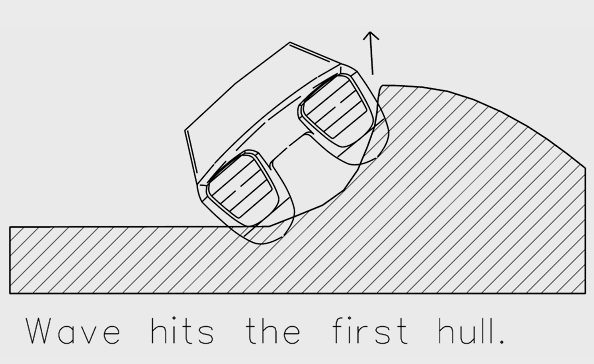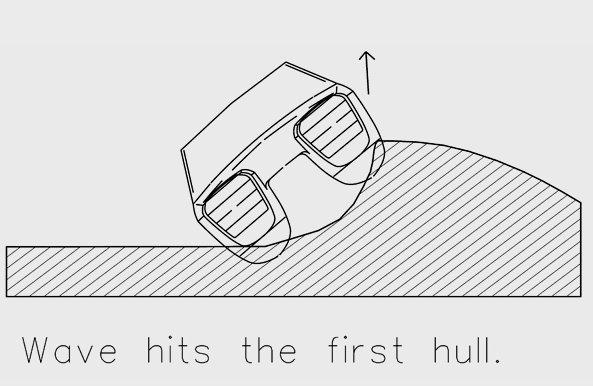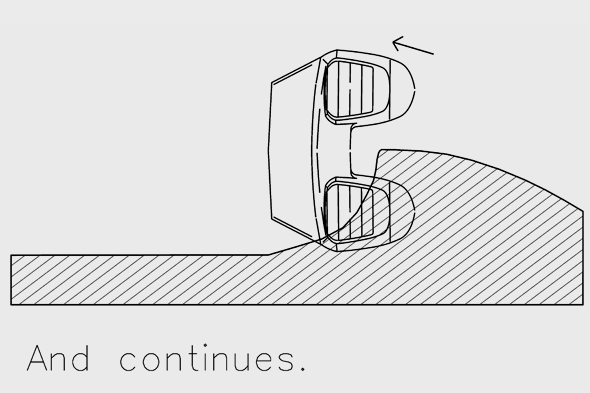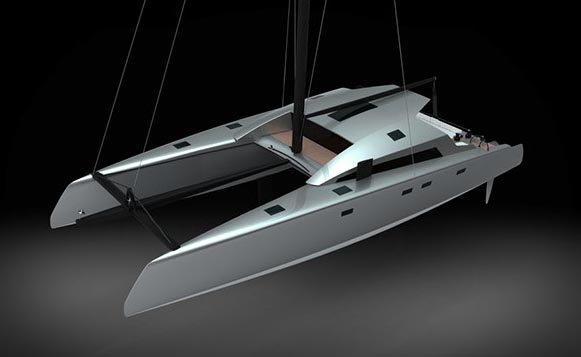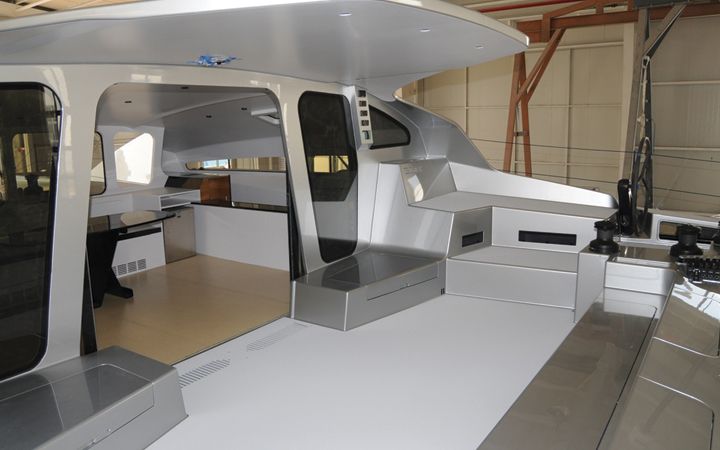Thanks again to Bill Gow for this.
http://cat2fold.wordpress.com/2013/02/28/zihuatenejo/#
I have to note that I designed Pantera back in the early 90s. It was the first design where I included the hull deck in the hull lines. More on Pantera when I get a chance.
Category Archives: New Designs
Oleophobic Coating
From Industrial Designer Daniel Simon ” Wow – oleophobic coating. Put that stuff on anything, and it stays clean, no matter what. I have no info about how toxic or non-toxic this is, but it is for sure extremely impressive !” Maybe we don’t need the windshield wipers.
More Catamaran Stability
Thanks everyone. The response has been great. Crowd sourcing works. I have been given valuable links and will forward to the USCG.
Among them, http://www.wumtia.soton.ac.uk/sites/default/files/CSYS2001BD.pdf
and
http://www.john-shuttleworth.com/Articles/NESTalk.html
the famous Richard Woods noted
“I saw the video Lock had made by the Wolfson Unit at Southampton University, and the evidence was very clear that catamarans behave as you drew. In our ISO stability work for the RCD we always assume that a boat in waves is stable until the wave height exceed the beam of the boat, irrespective of the number of hulls.”
USCG and Composite Materials Testing
Materials Testing for USCG Certified Vessels
One of my customers building my 36’ charter cat in the Ft. Myers area just got hit with an order to do all the testing highlighted in the list below. The price will be almost $4000.
In my experience, one of the surest indicators that your local OCMI is new or knows nothing about composites is if you are ordered to “test everything”. Customer would have been ordered to also do the C273, but I reminded the OCMI that those numbers are already available everywhere.
Old hands know that the most useful tests are those that can be plugged into structural calculations, such as ABS ORY. Those tests are: D790, D638 and D685. In fact many of us could simply from D790 results, tell you what the other test results would be within a few percent. You will not get a D790 result of 60,000 psi and a glass content of 40%.
An argument could be made for a shear test, but on long slender forms like our hulls, shear does not govern. And again, you would not get a great D790 result and a failing interlaminar shear result.
D3846 seems reasonable; if you have never been around modern composites. That test seems to be from the woven roving era. Any moderately well done hand lay-up of knitted fabrics will give around 55% glass content. Vacuum bagged and infused laminates can go even higher.
The C297 test is interesting. It seems reasonable enough. The problem is there is no threshold that I can find to use. What is the target number? ABS doesn’t have one. NVIC 8-87 has no target number. The customer is ordered to pay for a test where nobody can tell what a good or bad result is. Am I the only person amazed at the audacity? 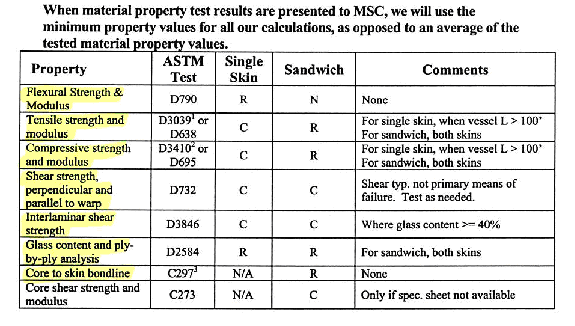
In these lean times we all have to work smart. Maybe in the flush 90s we could afford to do duplicate work. While the Coast Guard has the power to order builders to do anything, I urge them to use that power wisely to avoid duplication and wasted efforts. Work smart, work lean.
This paper will become a builders guide once I get time. I have gotten the composite structures and testing guru Ron Reichard to agree to work with the USCG on sensible testing policies. It seems so wrong that a local inspector who apparently knows little about composites can bully builders, with no recourse.
Catamarans and Waves
Catamarans and Waves
As I have noted before, the accident last November involving that poorly designed and narrow catamaran turned over by a wave seems to have now involved us all as multihull designers.
I was ordered, as I assume all other cat designers were, to create extensive static hydrostatic data at every possible and even impossible state of immersion. I even had to subcontract out GHS studies that could not be done with Prolines. Not one bit of the data shed any light on catamaran stability in waves. As my friend and naval architecture wunderkind Eric Sponberg wrote to me “I agree with you that running extensive hydrostatics doesn’t tell anyone anything” as to why a catamaran rolled over.
But the Coast Guard could and did order me to do that with the same tone of voice that the State Patrol uses when they order you out of the car.
I have heard it said that when a bureaucracy has no tools to deal with a crisis, they will rely on a blizzard of data. I seem to be seeing that.
I would have thought that they would have asked me or Roger or anyone else who has done a few dozen USCG certified cat designs what we thought. Not a word. Instead it was guns drawn and “you will comply”.
Eric recommended “For a better understanding of capsizing, the USCG should refer to C.A. Marchaj’s book “Seaworthiness–The Forgotten Factor”. It at least discusses the nature of capsizing, including catamarans.” I’m sure it was not done.
Actually there is a body of work that applied directly to this incident. Back in the ‘90s when I was in Tasmania, I had discussions with the late Lock Crowther on this very topic. He is the only one I know of who had done extensive tank testing on catamarans in large beam-on waves. The following is what I recall. I think it was published in Multihulls, but I have no idea what issue.
He explained that as the wave hits the first hull, that hull is of course flipped up in the air.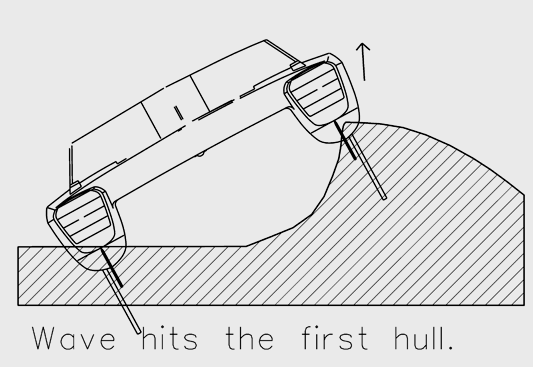
Then the wave charges along toward the next hull. During this time, the first hull stops moving up. When the wave hits the second hull, it is also flipped up. The first hull however has started going back down. 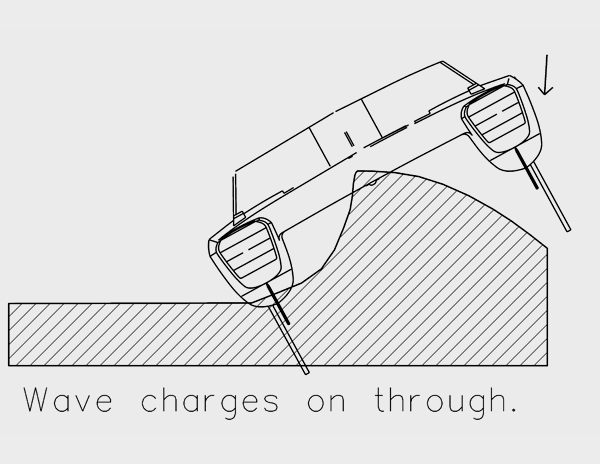
The wave hitting the second hull slams the first one back down and moves on. The wide cat remains flat on the water.
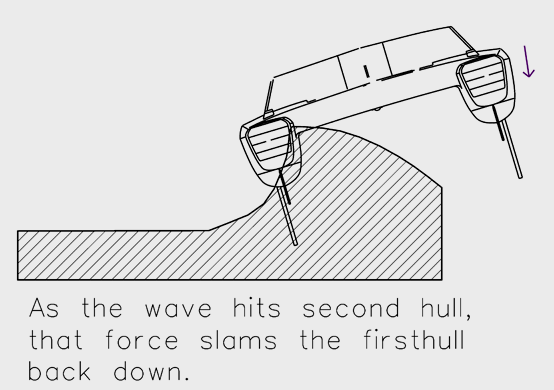
As far as I know, Lock did not study very narrow cats. As I often say, I can tell you what works. I can’t always tell you how bad something done wrong will be. So a wave hits a narrow cat beam on.
Ok that same size wave looks unfair to compare to. Lets give it a wave 25% smaller so it looks more fair. OK, smaller wave. But the first hull keeps going up.
I have a theory that the relevant factors are first, a relationship between wave height and center to center of hulls. Of course a small distance between hulls will cause a cat to get rolled in smaller waves.
I also see a critical relationship between wave speed and distance between hulls.
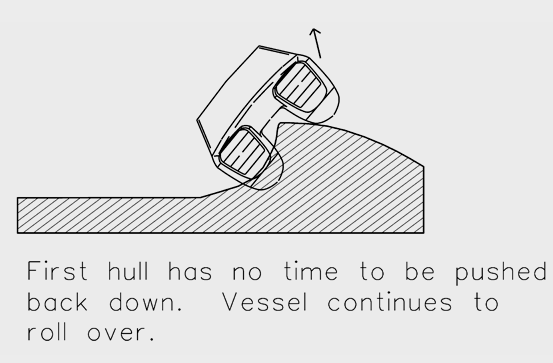
My theory is that with the narrow cats, the first hull never gets a chance to start to fall back down again. The wave it trapped between them as the first hull is still going up.
This could be a very useful thesis study for some student. I recall that Lock found that trimarans of the day behaved like the narrow cat above.
I believe it would have been smarter for the USCG to ask if any of us knew anything about this topic before going thug on us to help them generate a ream of useless data.
Engineering Apps
I found a large listing of design engineering apps for smart phones here at Design Engineering online. http://www.nxtbook.com/nxtbooks/level5/desktopengineering_201302/index.php?bm=normal#/28
More Coast Guard
Last November a very narrow charter cat rolled over from a wave in Florida. It looked like a powercat designed by guys who were chopper-gunning truck bed
covers just a few years ago. There was a fatality. http://articles.sun-sentinel.com/2012-11-23/news/fl-pompano-dive-boat-folo-20121123_1_rough-seas-hillsboro-inlet-high-seas
I supposed that it didn’t affect me since my boats were wide and safe.
Wrong.
I just spent several hours doing hydrostatic studies for the Coast Guard on one of my boats Trilogy Elua. The USCG required a study to be done at every 6″ of possible and impossible hull depths. Clearly they are flailing. None or the calcs revealed anything. They could have asked me or Roger (Hatfield) what to do. Instead, a blizzard of calculations, 95% having nothing to with the real world and stable catamarans. I have to figure out how to help them work smart. See also:
http://multihullblog.com/2012/11/charter-cat-rolls-over-in-florida/
The guy I usually deal with there is very very cranky this week. There must be a lot of pressure.
More Stuff Done (partly) Wrong
McConaghy 60 Catamaran.
This splashy, silver-rendered catamaran does have cool features like boards, and swept bows and rotating mast. And did I hear carbon fiber is involved? How cool is that?
It seems to lack a coherent mission statement though. It seems more like a couple dozen cool features spliced together by a beginner, than by the reputed experienced designers.
It has come to my attention that many of the conclusions that I came to from the pictures are wrong. If so, I stand corrected. For example, I thought from the minimal draft and use of carbon, it would be crazy light, which is good for speed. I understand that at 8.9 tons, its not as light as it looks. I also thought it was surprisingly narrow overall at 8.6m or 28′. It is also true that many of its peers are that narrow. My 60 is wider, though not that much wider at 30′. I will say that in the picture below, beam overall looks to be about 20′. That narrower beam lets them fly a hull very quickly. It could be very fast in even lighter winds. It is supposed to be a cruiser. With carbon beams, why not make it wider and give the extra righting moment and safety. Ok Ok, by being wider one would not fly a hull as easily and could lose a beer-can race. I have also been informed that at 75′ it has a very conservative rig. Isn’t that like having a Shelby Cobra with a Honda Civic engine in it. Why not give it a proper beam and a hotter rig? To match the badass look.
The house front is actually vertical. Even my pickup truck has some slope on the front. It has those trick swoop things on the sides though to make it look sleek; like the pug nosed ferries do to hide the pug.
I wondered if the first green wave (reverse bows do make wetter ride) trapped there would blow the front windows out? I have been informed that it will not.
And near as I could tell from the pictures, a wave boarding from astern had nothing to stop it from surging all the way downstairs, on both sides. I have been informed that it has doors and storm-boards. I have to accept that.
And I noticed no non-skid covered up the shining floor. I have been informed not to trust my eyes; it is non-skid.
Performance cats are expected to have small cabins. This is odd though; its smaller even than it needs to be. With elegant engineering, the beam shear web will be pretty near the mast. So why is all that “outside” there between the cabin front and the mast? Is it a place for the half dozen professional crew to stay? In my opinion a cruising boat should be able to be single-handed or short-handed. Usually that means the strings go aft to the helm, or helms. So why that stadium around the mast? If it were sailing in the Bass Strait like the night I was there, you could not be up there working the strings. Maybe they need a Bass Strait vacation.
Gunboat, it could be argued is ugly, but is a conceptually honest design.
I do read that the developer of this unit is the convicted securities trader Raphael Blot. I expect he forced these cool features together and the guys drafted like he ordered. It could have been so much better.
Another Fiberlay Class in seattle
Basic Composite & Mold Making Training Classes!
Saturday, February 23, 2013 9am – 3pm
Fiberlay – Seattle
24 South Idaho Street, Seattle, WA 98134
1-800-942-0660
Please see the attached PDF for more information:
http://www.fiberlay.com/emailblast/TrainingClasses-2-23-13.pdf
It is canadian viagra $50. Sometimes I can get free entry for my builders. I got that for the last event, but I don’t know if anyone went. Let me know and I will set it up.
Update: My builders can get in for half price if you contact Scott at Fiberlay with your name. Well in advance. On the road today, but will include Scott’s email on Monday.
Folding Kayak
Pretty impressive and inventive folding kayak. http://whatsnext.blogs.cnn.com/2013/01/31/the-origami-inspired-folding-kayak/?hpt=hp_c4
